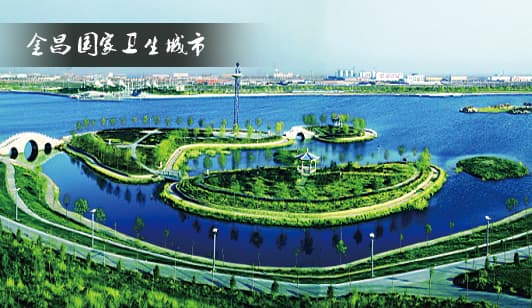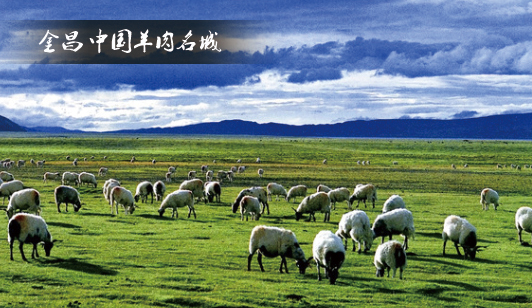- Profile Jurisdictions GOV DEPARTMENTS Cultures Travelling Educate
-
Jinchang was established as a mining settlement and later developed into a city to support its enterprises. Situated in the central section of the Hexi Corridor, it is known as the ‘throat of Hexi and gateway of the Silk Road’, serving as a vital node along the Belt and Road Initiative. Established as a city in 1981, it administers one district and one county (Jinchuan District and Yongchang County, whose names combined signify ‘gathering gold and prosperity forever’). The city comprises 12 townships, 6 subdistricts, 139 villages, and 43 communities. Covering a total area of 9,600 square kilometres, it possesses 1.8626 million mu of arable land and a population of 435,300, with an urbanisation rate of 78.43%. Renowned as ‘China's Nickel Capital’ for its abundant nickel deposits, it is the province's first National Civilised City and holds designations as a National Hygienic City, National Garden City, National Quality and Charm City, and National Model City for Supporting the Army and the People.

Its historical and cultural heritage is diverse. Human habitation dates back over 4,000 years, evidenced by the Yuanyangchi Site reflecting the Yangshao Culture of the primitive matriarchal clan society. It preserves China's best-maintained remains of the pre-Qin Northern nomadic Shajing Culture. The ancient city ruins of Lijian unravel the millennia-old mystery of the Western Han Dynasty's Roman legions. and the millennia-old Shengrong Temple, founded during the Northern Zhou Dynasty and extensively documented in Dunhuang Mogao Grotto murals and texts. This region stands as a crossroads of ethnic interaction and cultural convergence. During the revolutionary war era, the Red West Route Army fought fierce battles against enemy forces in Yongchang, establishing the first county-level revolutionary regime in the Hexi Corridor and composing a heroic chapter in revolutionary history. In 1958, a vast cohort of builders converged upon Jinchang from across the nation, braving sandstorms and battling the Gobi Desert to transform China's historical scarcity of nickel and cobalt. During his 1966 inspection tour, Comrade Deng Xiaoping affectionately dubbed it the nation's ‘treasure trove’ and a rare ‘golden child’.

Relatively abundant resources. Home to the world's third-largest and Asia's largest sulphide copper-nickel deposit—the Jinchuan Mine (① Russia's Norilsk Nickel Mine, nickel reserves: 16.85 million tonnes; ② Canada's Sudbury Nickel Mine, nickel reserves: 12.5 million tonnes; ③ Jinchuan Nickel Mine, nickel reserves: 6.25 million tonnes). Reserves of rare and precious metals including platinum, palladium, osmium, iridium, ruthenium, and rhodium rank first nationally. Abundant wind and solar energy resources are present, with an average annual solar radiation reaching 6,200 MJ/m². with an annual average of 2,955 sunshine hours. In designated wind power zones, measured annual average wind speeds exceed 5.8 metres per second at 70-metre heights, enabling the development of approximately 15 million kilowatts of wind and solar power capacity. The local supply rate for raw materials and auxiliary materials for new energy batteries reaches 75%. Currently, 2.7315 million kilowatts of wind and solar power capacity have been installed (accounting for 60.2% of the city's total installed power capacity). The city has been successively designated as one of China's first national demonstration bases for industrial resource comprehensive utilisation, a national new materials industrialisation base, a national high-tech industrial base for new materials, a national demonstration base for new industrialisation, a national new energy demonstration city, and a national circular economy demonstration city.

The industrial system is comprehensive. Jinchuan Group, a provincial state-owned enterprise based in Jilin, stands as a world-leading nickel-cobalt production base, a platinum group metals refining centre, and the largest copper producer in northern China. Ranked 339th on the Fortune Global 500 list, Annual production capacities for nickel, copper, cobalt, platinum group metals, gold, silver, and selenium stand at 200,000 tonnes, 1.1 million tonnes, 17,000 tonnes, 10 tonnes, 30 tonnes, 600 tonnes, and 200 tonnes respectively. Ranking third globally in nickel output, fourth in cobalt production, first nationally in platinum group metals, and fourth nationally in copper output. High-purity nickel and cobalt achieve ‘five nines’ purity, while high-purity copper attains ‘seven nines’ purity. Manufacturing spans 18 of the 31 major categories in the National Economic Industry Classification, with comprehensive production of the ‘three acids and two alkalis’ (annual output: sulphuric acid 2.5 million tonnes, hydrochloric acid 180,000 tonnes, nitric acid 150,000 tonnes, caustic soda 400,000 tonnes, soda ash 200,000 tonnes), and total chemical product capacity exceeding 9 million tonnes.
Agriculture exhibits distinct characteristics. Situated within the 38°N agricultural belt, the region features an average elevation of 1,800 metres, characterised by low rainfall, intense sunlight, significant diurnal temperature variation, and a dry, cool climate. Water resources primarily originate from glacial meltwater of the Qilian Mountains, with surface and groundwater quality meeting standards at 100%. The city ranks 24th nationally among prefecture-level cities in surface water quality assessment sections, while air quality compliance days consistently maintain around 300 annually. This favourable ecological environment nurtures a range of green, organic, and high-quality agricultural products, including Jinchang plateau summer vegetables supplied directly to the Guangdong-Hong Kong-Macao Greater Bay Area, premium forage grass with the nation's best comprehensive nutritional indicators, and the nationally certified geographical indication product ‘Yongchang Mutton’. Yongchang County is among the first batch of National Agricultural Product Quality and Safety Counties, while Jinchang City holds the provincial title of Agricultural Product Quality and Safety City.
Comprehensive supporting infrastructure is in place. The county hosts a national-level economic and technological development zone with well-developed infrastructure, providing favourable conditions for industrial transfer. Facilities include the Zijingyun Big Data Centre, equipped with advanced technology and fully licensed, and the Western Region's first operational digital freight logistics industrial park. The county also houses a postdoctoral research workstation, a national engineering technology research centre, and national and provincial key laboratories. Jinchang Customs operates locally. While high-speed rail service is yet to commence, a multi-modal transport network is well-established, centred on Jinchang Airport, the Lanzhou-Xinjiang Railway, Jincheng-Wuwei Expressway, and Jincheng-Arashan Railway. It hosts a major modern railway logistics hub in the Hexi region, serving as a vital transit point and distribution centre for coal shipments from Xinjiang to the east and from Inner Mongolia to the south. Energy corridors including the West-East Gas Pipeline, West-East Oil Pipeline, and West-East Power Transmission routes traverse the city.
contact details
Tel:00-86-0935—8234515
Address:甘肃省金昌市金川区新华路82号 No. 82 Xinhua Road, Jinchuan District, Jinchang City, Gansu Province
Working hours:Working days: 8:30 am – 12:00 pm 2:30 pm – 6:00 pm
